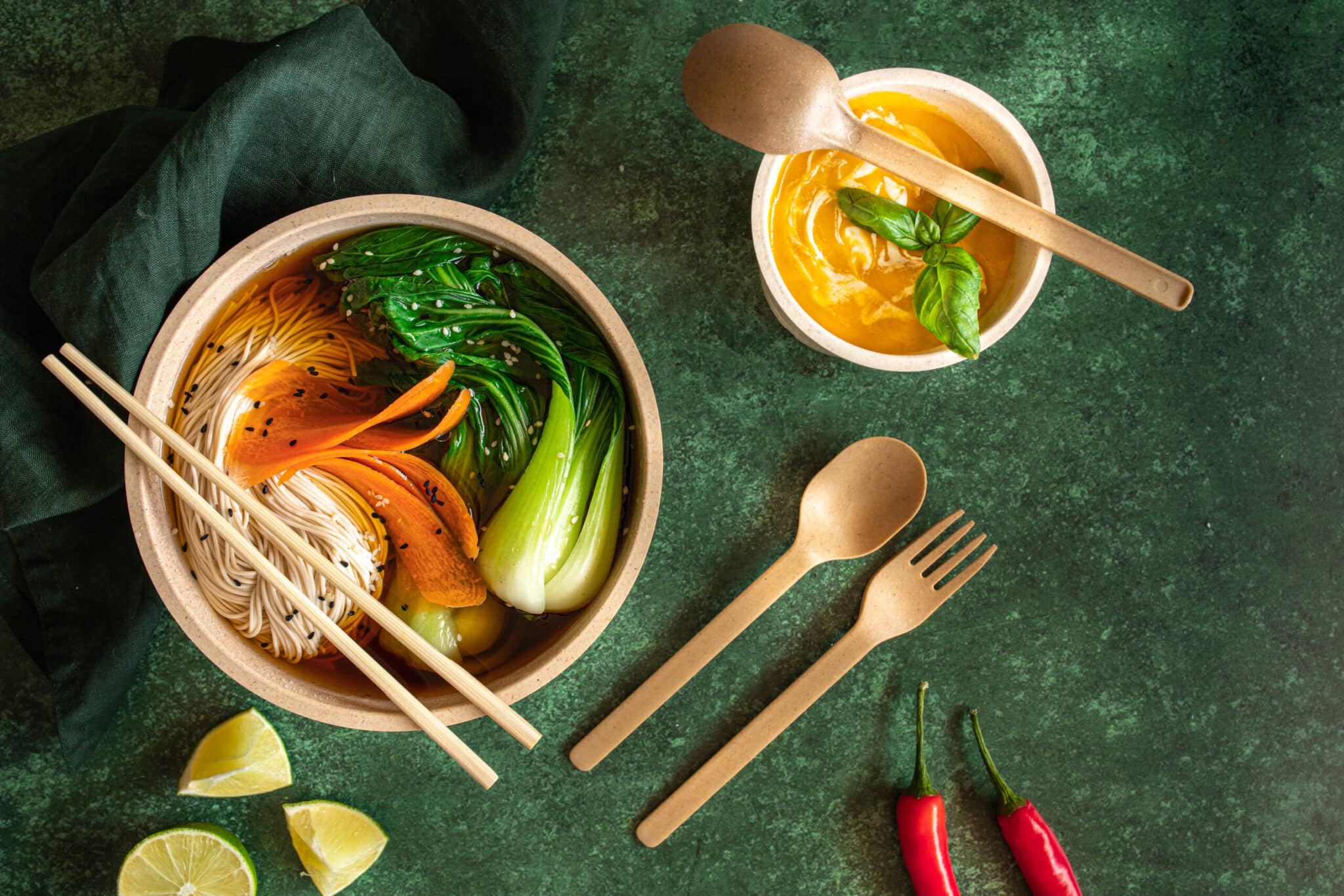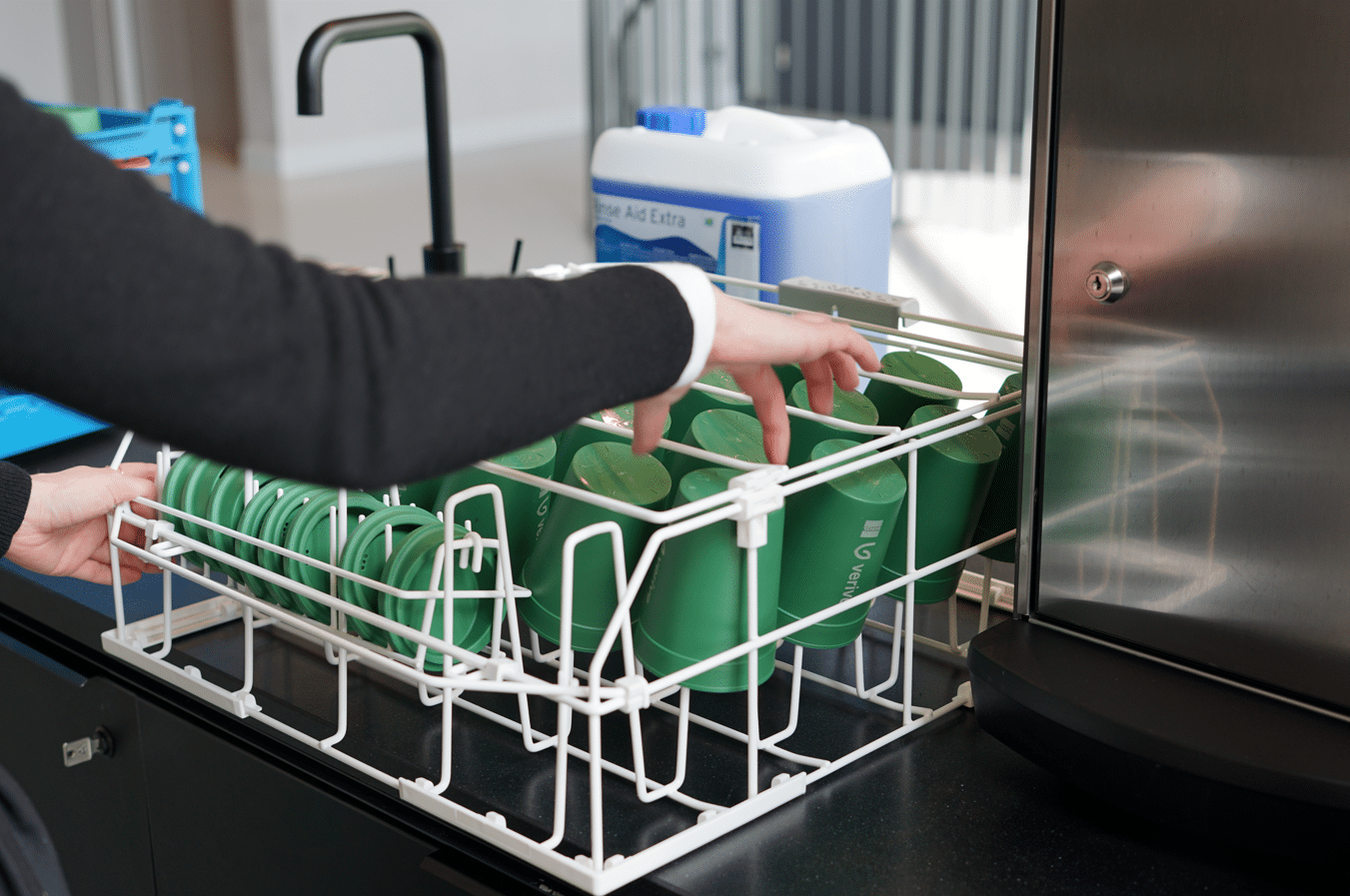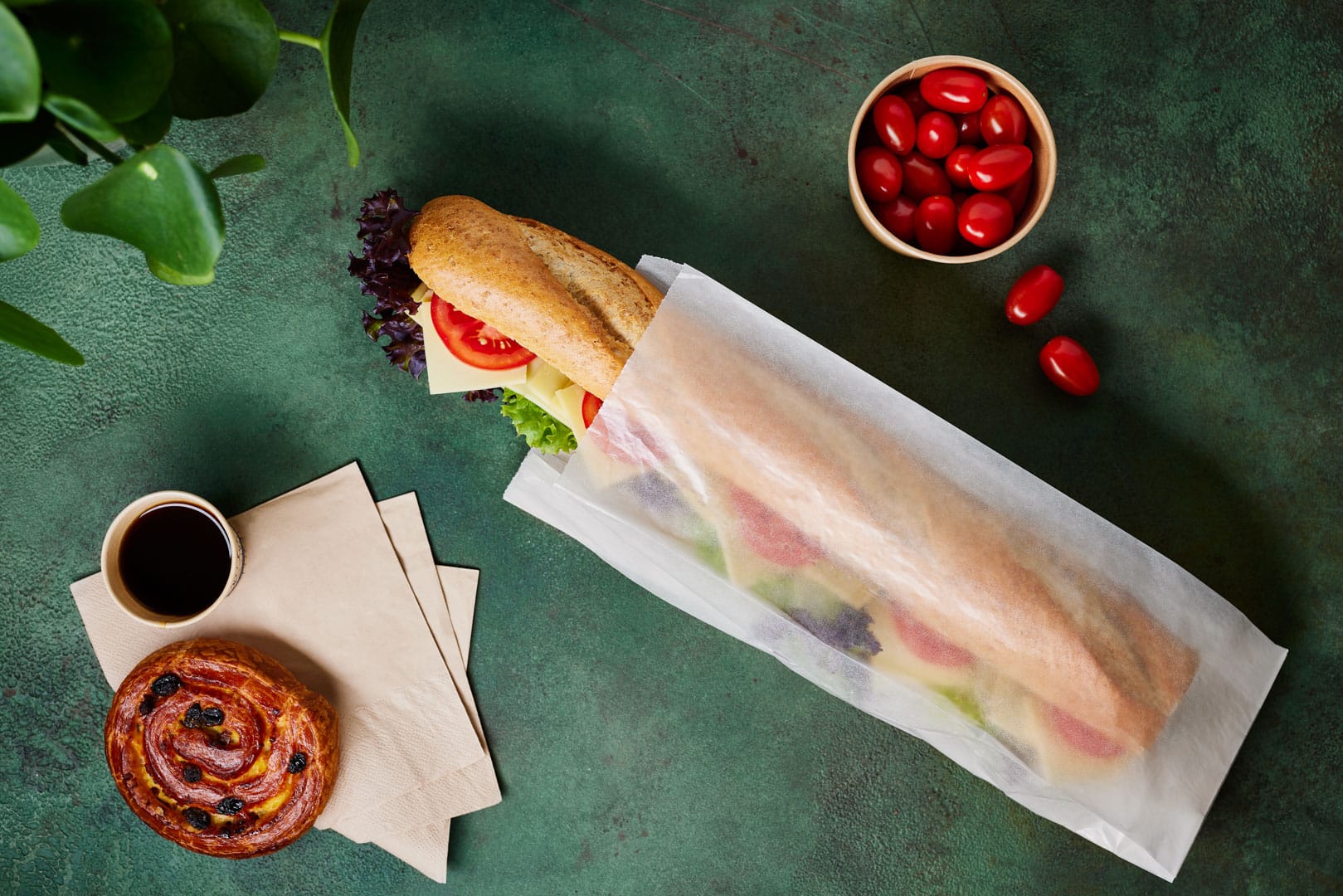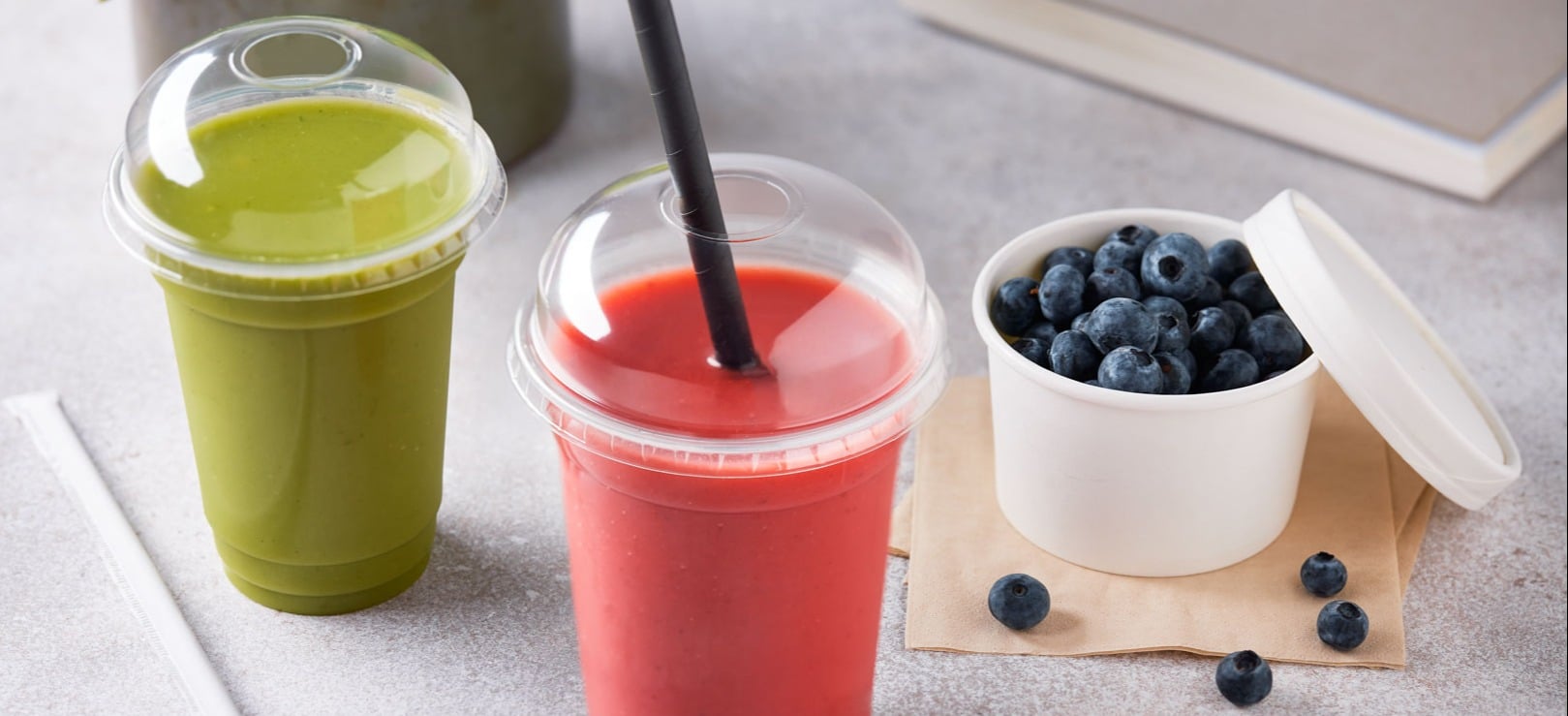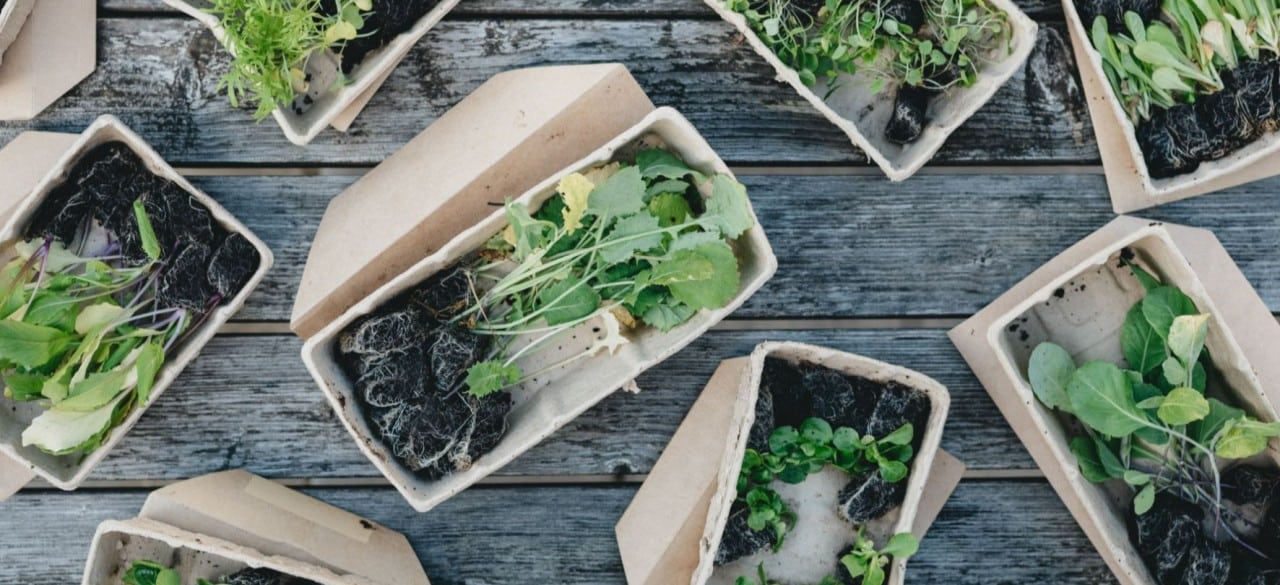About this article
This Verive guide offers advice on what reusable packaging is, how it’s affected by the Single-Use Plastic Directive, advantages and challenges of moving towards reusables, and the different ways you can make the switch in your own foodservice business.
As you prepare your foodservice business to comply with the continued roll-out of the EU’s Single-Use Plastics Directive, it’s worth considering whether to incorporate reusable packaging into your business model and how. Verive’s here with its latest handy guide that examines the options available to you when taking steps to offer reusable food packaging and cutlery.
What is reusable packaging?
According to the EU, reusable packaging is a product purposely designed, manufactured, and put on the market so that arrangements are at work to make reuse operational (EN 13449:2004). Simply put, it is packaging made to be durable enough to continue functioning for a significant use of time despite dishwashing. As we will see, some products marketed as ‘reusable’ fail to meet this basic definition.
For foodservice businesses and their customers, reusable packaging can mean a few different things. It might mean bring-your-own options, a range of products offered by the restaurant or café available for on-site purchase, or even a deposit scheme whereby containers are washed and reused within the premises’ own closed environment or off-site by a third party.
Whichever way it works, and whatever you think is best for your business, it’s important to remember the idea of reusing containers is not new. For example, it wasn’t that long ago that milkmen used to re-fill and re-use glass milk bottles. That’s not to say disposable packaging doesn’t have its place in the catering and hospitality, but let’s consider how the (re)normalisation of reusables might help you reach your sustainability goals.
What does the SUP Directive have to say about reusables?
The SUP Directive states that EU Member States need to make efforts to reduce waste from single-use plastic and set reduction targets at both local and national levels. Where there are restrictions, there must also be replacements, which is why many Member States are pushing for the uptake of reusable food packaging to meet said targets. For example in France, the government recently implemented legislation stating that any meal or snack eaten on-site needs to be consumed using reusable packaging or crockery solutions
The Directive also encourages reusable options by requiring businesses to charge consumers for non-plastic disposable alternatives. At the moment, pricing suggestions are vague, empowering foodservice businesses to interpret how much they choose to discourage the use of disposable options depending on what works for their sustainability strategy.
Why opt for reusable packaging?
If reusable packaging is used appropriately for its full lifespan, there are enormous environmental benefits. That’s because fewer virgin resources are needed to manufacture reusables than the potential hundreds of disposable equivalents they stand in for. Therefore, reusables massively cut down on end-of-life plastic waste and the use of raw materials.

Importantly, reusables clear up consumers’ confusion about responsible disposal. They no longer need to question whether their used packaging belongs in a bin, the recycling, or should be sent for industrial composting. Instead, they know they can simply keep it, wash it, and use it again. With all this in mind, reusables offer a brilliant way to improve your sustainability credentials and stay one step ahead of the coming SUP Directive requirements.
Furthermore, with increasingly environmentally-conscious consumers, you get the opportunity to give your customers choice and support the change in public consciousness, all while freeing yourself from the stocking and supply chain issues affecting resources like rPET on which the manufacture of single-use disposable packaging depends. This year, shortages of cups, straws, and takeout containers have taken their toll on the foodservice industry, affecting businesses on a global scale.
What are the potential drawbacks of reusables?
Despite the huge potential benefits, foodservice businesses mustn’t make the switch to reusables without some prior thought. These are some of the potential issues worth considering before making the plunge.
-
Reusables are more expensive: Because they are built to last, they use more virgin resources to manufacture. Therefore, reusables have a greater initial environmental impact and cost more to design, manufacture, and market. The carbon footprint created from transport and the water used to clean them must also be factored in. With this in mind, it only makes sense, environmentally and economically speaking, to pursue reusable options if businesses and customers alike commit to the cause of reuse.
-
In closed-loop options (discussed below), reusables must be washed on-site or by a third party partner. This creates more work for staff and requiring washing facilities that many businesses might not already have in place. Moreover, washing up uses energy, which ultimately adds to the carbon footprint of every reusable product over its lifespan.
-
Some market players are exploiting changing attitudes towards disposables, simply rebranding slightly heavier disposable packaging as ‘reusable’ (i.e., thick plastic cutlery) despite them not being robust enough for repeated dishwashing and use. At Verive, we strongly discourage this disingenuous shift to reusables because it’s not in the spirit of sustainability. It confuses consumers given they are familiar with these products as disposable. That means they are unlikely to change their behaviour and start reusing something they previously chucked away. By Verive’s standards, reusables must be able to endure industrial dishwashing facilities without damage for a significant number of reuses. Remember this important criteria when considering your sourcing options.
-
Not enough emphasis (or laws) are in currently in place concerning hygiene and reusables. More conversations need to be had about this important topic, namely: Who decides whether a reusable is clean enough to be food safe? Who decides when a product has reached its end of life (e.g., our products have approximately 200 reuses, but who decides when it's no longer suitable for reuse)? Reusables have more creases, hinges, and clasps, and therefore, there are more opportunities for bacteria to linger. So how do we know people clean them properly especially in the era of COVID-19? This topic is critical for public health and sustainability because if people aren’t comfortable using reusables products, then these systems won’t prevail in the long run.
As we don't want to compromise public health and sustainability, Verive is very clear about what we market as reusable and why we are so transparent about both the advantages and the challenges.
What does Verive suggest when it comes to reusables?
At Verive, we think a hybrid approach works best. Foodservice businesses should offer a mix of reusable options and responsibly sourced, recyclable or compostable disposables. Let’s face it, consumers are not always going to have a bring-your-own option available the moment they feel peckish. And they’re not always going to want to buy reusable packaging to eat from if they must carry it around, especially if they know they have previously purchased reusable products waiting for them at home!

At this moment – as the tide’s turning on packaging options and we wait for consumer behaviour to catch up with what foodservice businesses are beginning to offer – consider taking a more dynamic approach and simply give your customers options. What do we mean? Do as we say and as we do, offer both reusables and sustainably sourced, recyclable alternatives. Not sure where to start? Check out our range.
In practical terms, how will this work for your foodservice business?
As mentioned, the switch to reusables can mean quite some different things and you’ll need to evaluate what works best for your business. Here are a few options of how you might incorporate reusables into your restaurant or takeaway business:
-
Closed loop with washing facilities: A closed-loop process is suitable for on-site consumption. Customers are served their food in reusable packaging, enjoy their food, and return the containers once they’ve finished. You might ask, is this not effectively what sit-down restaurants have always done? Yes, it’s as simple as that, applying workable, age-old restaurant practices to fast-food settings, enlivened with more suitable, robust sustainable materials.
-
Deposit schemes: This process works much like the closed loop approach, however, to take containers off-site for to-go or delivery options, customers will need to pay a small fee. Then, once the containers are returned, they receive their deposit back.
-
Bring your own: Customers have the option to present their own containers to be filled with your own food and beverages. The restaurant serves food according to their standardised portions and the customer can leave without worrying about bringing anything back. In this scenario, it’s important to ensure what the customer presents is food-safe.
-
Offer purchasable reusable products: If customers won’t always have a bring-your-own option, they can purchase the most suitable container from a range of reusable options offered for sale by the restaurant or cafe. They can consume their food on site or take it with them. Either way, they don’t need to worry about returning anything, and they have a bring-your-own option for next time.
These are all effective ways of making the change towards reusables, but remember, you need not commit to just one. Go for a hybrid approach that combines several of these options.
What are other companies doing?
As previously mentioned, reusable packaging is not a new phenomenon. However, companies are now experimenting with creative ways to encourage their customers to move away from disposables, both on-site and for to-go options, and start thinking reusable.
For example, the start-up Loop launched itself onto the scene as an e-commerce platform selling food, beauty products, and household essentials, all in reusable packaging. How does this work? Consumers might order quinoa in a canister or face cream in a jar. Once used, they send back the empty packaging for cleaning and refilling and repeat the cycle in an effective, closed-loop circular economy. Simple as that.
Burger King has recently struck up a partnership with Loop, trialling reusable packaging for select menu items in certain U.K. restaurants. In their bid to help reduce end-of-life waste, Burger King will give its customers the option to pay a £1 deposit for a reusable cup or container instead of single-use packaging.
Where should you go from here?
You still have time before the next phase of legislation comes into effect, but we recommend you start thinking about what you’re going to put in place now. Interested in finding out how you can stay one step ahead of the Single-Use Plastics Directive and incorporate reusables into your foodservice business? Let’s get in touch.
And make sure you take a look at our reusables range and the disposable products they complement so perfectly.
